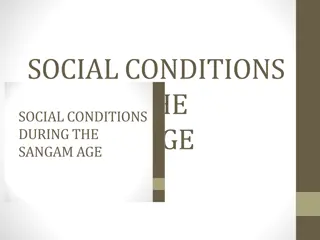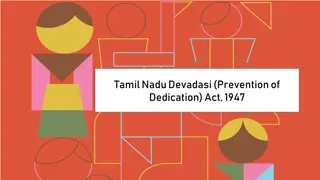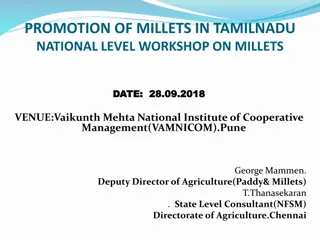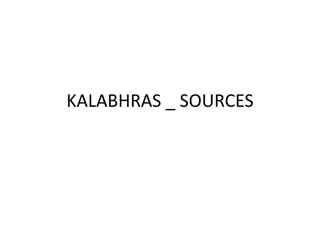History of Tamil Nadu: The Sangam Age and Literary Sources
The history of Tamil Nadu during the Sangam Age is rich with literary excellence from the Tamil Sangam, where poets composed significant works. The three Sangams were pivotal in preserving Tamil literature under royal patronage, providing insight into the social, political, and economic conditions of the era. Alongside native sources, foreign authors like Megasthenes also shed light on the commercial interactions of South India.
Download Presentation

Please find below an Image/Link to download the presentation.
The content on the website is provided AS IS for your information and personal use only. It may not be sold, licensed, or shared on other websites without obtaining consent from the author.If you encounter any issues during the download, it is possible that the publisher has removed the file from their server.
You are allowed to download the files provided on this website for personal or commercial use, subject to the condition that they are used lawfully. All files are the property of their respective owners.
The content on the website is provided AS IS for your information and personal use only. It may not be sold, licensed, or shared on other websites without obtaining consent from the author.
E N D
Presentation Transcript
Sangam Age __ Meaning The word Sangam means an Association Here , it refers to the Tamil Sangam , An Association of Tamil Poets , which flourished in ancient Tamil Nadu . These Tamil Poets had composed the Sangam literature . The period in which these literatures were composed is called the Sangam Age in the History of Tamil Nadu .
SANGAM AGE The Sangam Age constitutes an important chapter in the history of South India . According to Tamil Legends , there existed three Sangams ( Academy of Tamil Poets )in ancient Tamil Nadu popularly called Muchchangam . These Sangams flourised under the royal patronage of the Pandyas . The first Sangam , held at Then Madurai , was attended by gods and legendary sages but no literary work of this Sangam was available . The Second Sangam was held at Kapadapuram , but all the literary works had perished except Tolkappiyam . The Third Sangam at Madurai was founded by Mudathirumaran . It was attended by a large number of poets who produced voluminous literature but only a few had survived . These Tamil literary works remain useful sources to reconstruct the history of the Samgam Age .
Sources ___ Literature . The Sangam literature includes Tolkappiyam , Ettutogai , Pattupattu , Pathinenkilkanakku and the two Epics __ Silappathigaram and Manimegalai . Tolkappiyam authored by Tolkappiyar is the earliest of the Tamil literature . It is a work on Tamil grammar but it provides information on the political and Socio- Economic conditions of the Sangam period . The Ettutogai or Eight Anthologies consist of eight works Aingurunooru Narrinai Agananooru Purananooru Kuruntogai Kalittogai Paripadal and Padirruppattu .
The Pattuppattu or Ten Idylls consist of ten works __ 1. Thirumurugarruppadai 2. Porunararruppadai 3. Sirupanarruppadai 4. Perumpanarruppadai 5. Mullaippattu 6. Nedunalvadai 7. Maduraikkanji 8. Kurinjippattu 9. Pattinappalai and 10. Malaipadukadam .
Both Ettutogai and Pattuppattu were divided into two main groups __ Aham and Puram Pathinenkilkanakku contains eighteen works mostly dealing with Ethics and Morals . The most important among them is Tirukkural authored by Thiruvalluvar . Silappathikaram written by Elango Adigal and Manimegalai written by Sittalai Sattanar . It provides valuable information on the Sangam Polity and Society .
Foreign Literary Sources In addition to the Sangam literature , the Greek authors like Megasthenes , Strabo , Pliny and Ptolemy mention the commercial contacts between the West and South India . The Asokan Inscriptions mention the Cheras , Cholas and Pandya rulers on the south of the Mauryan empire . The Hathikumbha inscriptions of Kharavela of Kalinga mention about the Tamil Kingtoms. The Excavations at Arikkamedu , Poompuhar , Kodumanal and other places reveal the overseas commercial activities of the Tamils . Foreign literary accounts remaine useful sources for the study of the Sangam Age . Greek and Roman writers had mentioned about the society and economy of the Sangam Tamils in their accounts . Megasthanes in his book Indica referred to the Three Tamil Kingdoms Excavations Several monuments of Sangam have been brought to light by the excavations conducted at various places in Tamil Nadu .
Robert Bruce Foote conducted excavations at Adhichanallur , where he found a large number of articles made of Iron , Bronze and Gold . They depict the life of the ancient Tamils . Dubreuil and Mortimer Wheeler also made excavations at Arikkamedu near Pondicherry . Roman Pottery , Glass bowls , Gems and Coins have been found there . These findings confirm the commercial contact between the Roman Empire and Tamil country during the Sangam Age . A Buddhist Vihara was found at Kilaiyur near Kaverippumpattinam . It belonged to the Post Sangam period and provides lot of evidences of Sangam Age . Other important sites of excavations are Uraiyur , Kanchipuram and Kodumanal .
The Under Water Archaeology has also developed recently and excavations have been made under the sea near Poompuhar . A Shipwreck has been found there . Coins . The study of Coins is called Numismatics . The Tamil Kings of the Sangam period issued gold and silver coins but they are not found in large numbers However , Roman coins made of gold and silver re found all over Tamil Nadu . These coins further confirm the trade relations between Tamil country and Rome during the Sangam Age .
.Period of Sangam Literature The Chronology of the Sangam literature is still a disputed topic among the scholars . The Sri Lankan ruler Gajabhagu II and Cheran Senguttuvan of Chera dynasty were contemporaries . This is confirmed by Silappathigaram as well as the Dipavamsa and Mahavamsa . It help to fix the date of the Sangam The Roman Coins issued by Roman emperors of the first century A.D were found in plenty in various places of Tamil Nadu . Therefore , the most probable date of the Sangam literature has been fixed between the third century B.C to Third Century A.D on the basis of Literary , Archaeological and Numismatic evidences .
Political History : Tamil Kingdoms : The Tamil Country was ruled by three dynasties , namely Chera, Chola and Pandya Kingdoms . They were popularly known as Muvendar . In addition to these three Kingdoms , there were also local Chieftains . The most famous among the local Chieftains were the Seven patrons , popularly known as Kadaiyelu Vallalgal . They were Paari , Oori , Kaari, Aoy , Adhikaman , Began , Titles and Symbols : The Chera Kings assumed titles like Vanavaramban , Vanavan , Kuttuvan , Irumporai and Villavar . The Chola Kings like Senni , Valavan , and Killi . The Pandya Kings Thennavar and Minavar .
Each of the Sangam dynasties had a royal emblem Carp for the Pandyas Tiger for the Cholas and Bow and Arrow for the Cheras . Chera Kingdom : The Cheras ruled over the parts of Modern Kerala . Their Capital was Vanji and their important seaports were Tondi and Musiri . Their Symbol in the Flag was Bow and Arrow . They had the Palmyra Flowers as their garland . The Pugalur Inscription of the first century AD refers to three generations of Chera rulers . Padirruppattu also provides information on Chera Kings .
Perum Sorrtru Udhiyan Cheralathan , Imayavaramban Nedum Cheralathan and Cheran Senguttuvan were the famous rulers of this dynasty . The Chera Kings of the Sangam Age were known by many titles such as Vanavar , Villavar and Malaiyar . Cheran Senguttuvan was the most popular king of the Sangam Cheras The Sangam works , Padhithruppattu and Ahananuru provide a lot of information about Cheran Senguttuvan . The Tamil Epic Silappathigaram also tells about his military achievements . Senguttuvan led to an expedition up to the Himalayas . Senguttuvan crossed the river Ganges and defeated his enemies . Senguttuvan reached the Himalayas and hoisted the Chera Flag . Senguttuvan brought stones from there and built a temple in memory of Kannagi
Senguttuvans brother Elango Adigal composed Silappathigaram . Padhithruppattu and other Sangam literature give a long list of Chera Kings . The most popular among them were Cheralathan , Peruncheral Irumporai and Kanaikkal Irumporai . The territory of the Sangam Cheras mostky comprises the present Kerala State . Among his military achievements , his expedition to the Himalayas was remarkable . He defeated many north Indian Monarchs . He introduced Pattini Cult or the Ideal wife in Tamil Nadu . The stone for making the Idol of Kannagi was brought by him after his Himalayan expedition .























